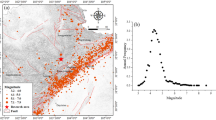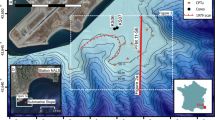Abstract
Previous investigations have shown that the seismic response of slopes during the Wenchuan earthquake was highly variable. The present study tries to give an answer to the question: Which are the main factors affecting the seismic response degree of slopes? With the support of the China Geological Survey Bureau, we set 3 monitoring sections in Jiulong slope, Mianzhu city, China with the aim to record the site response of the slope during the aftershocks of the Wenchuan earthquake. After the Wenchuan earthquake, which happened on 12 May 2008, 30 aftershocks have been recorded in these monitoring points. We analyzed 11 records, with magnitudes ranging from ML = 4.6 to ML = 3.1. The amplification factors of the horizontal compound PGA and 3D compound PGA have been determined for the 3 points at different elevations on the slope. Results showed that the dynamic response of the slope on the earthquake was controlled by factors such as topography and the thickness of the Quaternary overburden.
Similar content being viewed by others
References
Ashford SA, Sitar N (1997) Analysis of topographic amplification of inclined shear waves in a steep coastal bluff. Bulletin of the Seismological Society of America 87: 692–700.
Ashford SA, Sitar N, Lysmer J, Deng N (1997) Topographic effects on the seismic response of steep slopes. Bulletin of the Seismological Society of America 87: 701–709.
Celebi M (1987) Topographic and geological amplification determined from strong motion and aftershock records of March 1985 Chile earthquake. Bulletin of the Seismological Society of America 177: 1147–1167.
Clark M, Royden. LH (2000) Topographic ooze: building the eastern margin of Tibet by lower crustal flow. Geology 28: 703–706.
Davis LL, West RL (1973) Observed effects of topography on ground motion. Bulletin of the Seismological Society of America 63: 283–298.
David MB (1972) A Note on the effect of simple topography on seismic SH waves. Bulletin of the Seismological Society of America 62: 275–284.
Feng XJ, Jin XS (2001) Analysis on amplification effect of bed rock peak acceleration caused by site soil. Journal of Engineering Geology 9(4): 385–400. (In Chinese)
Hartzell SH, Carver DL, King KW (1994) Initial investigation of site and topographic effects at Robinwood ridge, California. Bulletin of the Seismological Society of America 184: 1336–1349.
Huang HC, Chiu HC (1999) Canyon topography effects on ground motion at feitsui damsite. Soil Dynamics and Earthquake Engineering 18: 87–99.
Kawase H (1990) Topographic effect at the critical SV waves incidence: possible explanation of damage pattern by the Wittier Narrow, California, earthquake of 1 October 1987. Bulletin of the Seismological Society of America 80: 1–22.
Lee SJ, Komatitsch D, Huang BS et al. (1999) Effects of topography on seismic-wave propagation: an example from northern Taiwan. Bulletin of the Seismological Society of America 99: 314–325
Liu HB, Zhu X (1999) Advance on topographic amplification effects of seismic response. World Information of Earthquake Engineering 15(3): 20–25.
Liu CS, Lu ML (1998) Preliminary analysis of the seismic amplification effect in Shanghai. Shanghai Geology 1: 8–13.
Liu JB (1996) The effect of local irregular topography on seismic ground motion. Acta Seismologica Sinica 9(2): 309–315.
Michel Bouchon (1973) Effect of topography on surface motion. Bulletin of the Seismological Society of America 63: 615–632.
Ministry of Construction, P. R. of China (2001) Code for Investigation of Geotechnical Engineering GB 50021–2001. China Building Industry Publishing House, Beijing, China.
Nishimura N, Yagi, Y (2008) Rupture Process for May 12, 2008 Sichuan Earthquake (Ver. 2). http://www.geol.tsukuba.ac.jp/~nisimura/20080512 (Accessed on June 11, 2008)
Pedersen H, Brun BL, Hatzfeld D et al.(1994) Ground-Motion Amplitude across ridges. Bulletin of the Seismological Society of America 84: 1786–1800.
Qi SW, Wu FQ, Liu CL, et al. (2004) Engineering geology analysis on stability of slope under earthquake. Chinese Journal of Rock Mechanics and Engineering 23(16): 2792–2797.
Wang G, Kamai T (2010) A Large Landslide Triggered by the 2008 Wenchuan (M8.0) Earthquake: Insights for Seismic Motion. 2010 Taylor & Francis Group, London, ISBN 978-0-415-60034-7.
Xu GX, Yao LK, Li ZH et al. (2008) Dynamic response of slopes under earthquakes and influence of ground motion parameters. Chinese Journal of Geotechnical Engineering 30(6): 918–923.
Zafeiria R, Anastasia K, Nikolaos T (2004) Stochastic Strong Ground-Motion Simulation of the 7 September 1999 Athens (Greece) Earthquake. Bulletin of the Seismological Society of America 94(3): 1036–1052.
Author information
Authors and Affiliations
Corresponding author
Rights and permissions
About this article
Cite this article
Wang, Y., Luo, Y., Wang, F. et al. Slope seismic response monitoring on the aftershocks of the Wenchuan earthquake in the Mianzhu section. J. Mt. Sci. 9, 523–528 (2012). https://doi.org/10.1007/s11629-012-2179-y
Received:
Accepted:
Published:
Issue Date:
DOI: https://doi.org/10.1007/s11629-012-2179-y




